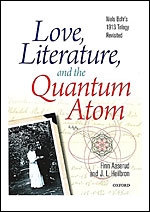There are anniversaries, and there are anniversaries. This year marks a century since Niels Bohr introduced his peculiar atom—the one that purposefully ignored parts of traditional—classical—physics. The Royal Danish Academy of Sciences and Arts marked this event with a scholarly conference in Copenhagen in early June 2013.

The event began with a masterful lecture, “My courage is ablaze so wildly,” by John L. Heilbron, well-known scholar of the history of quantum physics. (Professor Heilbron also helped the AIP History Programs in fundamental ways in the 1960s and forward. A video of his lecture is available on the conference website.) His lecture drew from private letters in the Bohr family collection, recently made available for the first time. Professor Heilbron made clear the emotional commitment of Niels Bohr to this new and expansive view of the physics of the atom.

The main organizer of this conference was Dr. Finn Aaserud, director of the Niels Bohr Archive at the Niels Bohr Institute in Copenhagen. Aaserud, we should note, was a post-doc and associate historian at AIP in the 1980s. The conference was supported financially by the Carlsberg Foundation and hosted by the Royal Danish Academy.
The Niels Bohr centenary featured presentations by 34 speakers from 19 countries. Participants included physicists, historians and philosophers of science specializing in the early years of quantum physics, and a few historians who focus on related context.
As the first speaker, Prof. Helge Kragh (University of Aarhus, Denmark) made clear, the Bohr atom was a concept in flux, from its beginning.
Some speakers, e.g., Jaume Navarro (University of the Basque Country, Spain) stressed the state of physics into which Bohr plunged ca. 1913. Others spoke about the Correspondence Principle and other fundamental ideas introduced or emphasized by the new approach of Niels Bohr.

Conference speakers also brought forward contrasts between different quantum mechanical schools, early and ignored advocates of the possibility of nuclear fission, and Bohr’s firm commitment to neutrality and international scientific collaboration. Shown right is Thiago Hartz, a graduate student from the Federal University of Bahia, Brazil, who co-presented with Olival Freire on “Uses and appropriations of Niels Bohr’s ideas about quantum field measurements, 1935-1965. Hartz will soon defend his dissertation in the history of quantum physics and begin a post-doc at the Niels Bohr Archive in Copenhagen.
Events like the Bohr-atom centenary provide important opportunities to call together the variety of scholars needed to preserve the history of physics and explore its many dimensions. We hope that AIP and the Niels Bohr Archive and Institute in Denmark will find many more opportunities to work together to promote the history of physics in the future.
The Royal Danish Academy will publish the proceedings of the conference as a commemorative volume.
